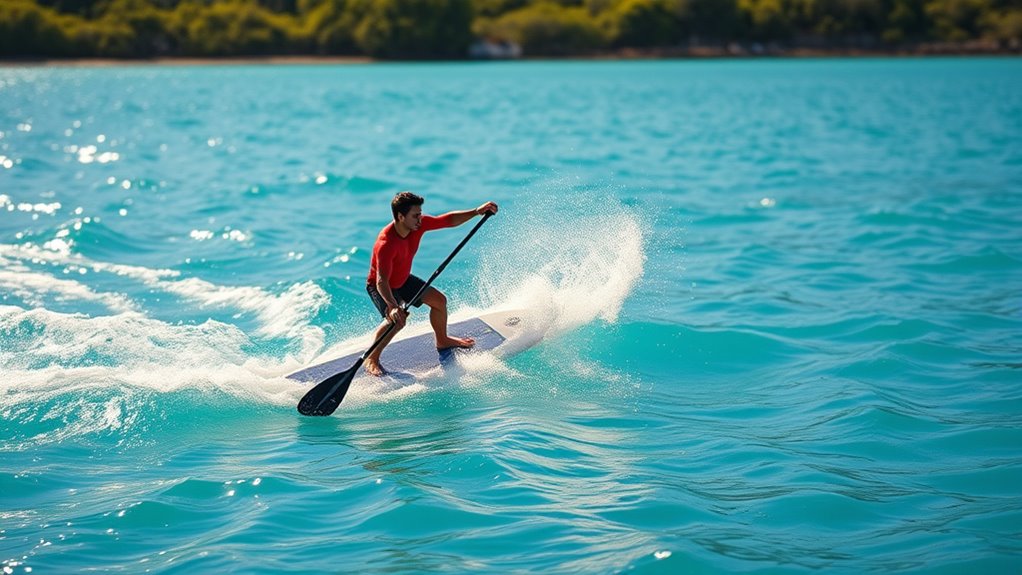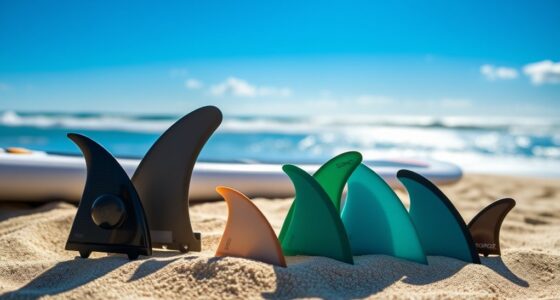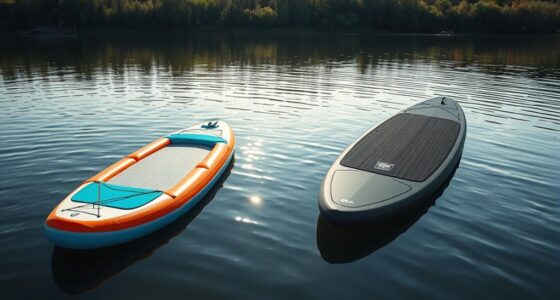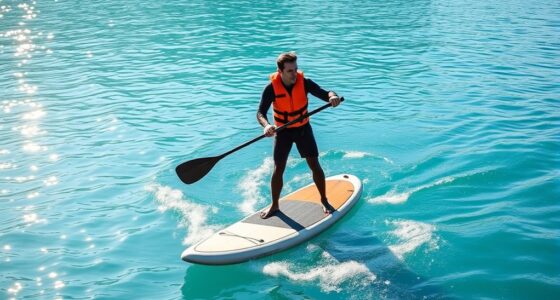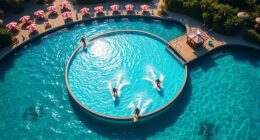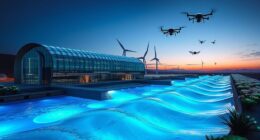To instantly boost your SUP speed, focus on key paddle strokes like the Reach and Power Pull, which maximize full-body engagement and maximize drive. Use your core and legs to add stability, keeping your paddle vertical and fully submerged during each stroke. Smooth, controlled motions help reduce drag and fatigue. Practice variations like the Draw, Slant Pull, and Sweep to find what works best. Master these techniques, and you’ll see faster rides—keep going to discover more effective strokes.
Key Takeaways
- Engage your core and rotate your torso to generate more power with each stroke.
- Reach fully forward with the blade submerged before pulling back smoothly to maximize efficiency.
- Keep the paddle vertical during the stroke to optimize power transfer and reduce drag.
- Use your legs and hips to drive the stroke, avoiding over-reliance on arm strength alone.
- Maintain a steady, controlled rhythm with deliberate, full-body movements for instant speed gains.
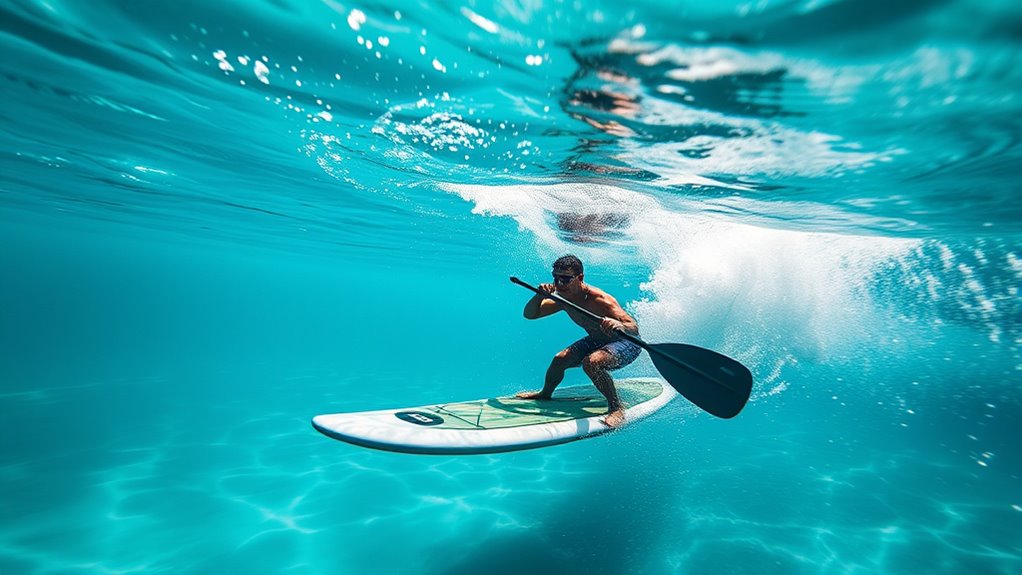
Ever wondered how to paddle faster on your stand-up paddleboard? The secret lies in mastering the right techniques overview and choosing the proper equipment selection. When you focus on these areas, you’ll notice an immediate boost in your speed and efficiency on the water. Improving your paddle strokes isn’t just about putting in more effort; it’s about making each stroke count. By understanding the fundamental techniques and selecting gear that complements your style, you can glide across the water with less fatigue and more confidence.
Master proper techniques and gear choices to paddle faster and more efficiently on your stand-up paddleboard.
Start with your technique overview. A common mistake is relying solely on arm strength, but effective paddling involves your entire body. Engage your core, rotate your torso, and use your legs to stabilize. When you paddle, reach forward with your blade fully submerged, then pull it back smoothly alongside your board. Keep your paddle vertical to maximize power transfer and minimize drag. As you pull, focus on a steady, controlled motion—don’t yank or rush the stroke. The more deliberate your movements, the more speed you generate with less energy.
Equipment selection plays an essential role in your speed gains. A paddle that’s too long or too short can hinder your efficiency. Your paddle should reach somewhere between your chin and nose when standing upright, allowing for a comfortable reach without overextending. The blade shape also matters; a larger, wider blade provides more power for each stroke, but might be harder to control at high speeds. Conversely, a narrower blade offers better control and less fatigue during long paddles. The paddle’s material can influence your performance too—carbon fiber paddles are lightweight and stiff, translating to more effective strokes, while aluminum models are durable but heavier.
Your board’s shape and size also impact your speed. A longer, narrower board glides faster and cuts through the water more efficiently, making it easier to maintain higher speeds once your technique and equipment are optimized. Ensure your fins are appropriate for your paddling style; more fins provide stability, but can create extra drag if not suited to your needs. Additionally, understanding projector contrast ratio can help you optimize your viewing experience when watching water sports or instructional videos, which can further improve your technique.
Finally, practice makes perfect. Combine your improved technique overview with carefully selected equipment, and you’ll find yourself paddling faster with less effort. Focus on fluid, deliberate strokes, and don’t forget to adjust your gear as you improve. Small tweaks in your stance or paddle length can make a big difference. With consistent practice and attention to equipment selection, you’ll soon enjoy the thrill of slicing through the water with effortless speed.
Frequently Asked Questions
How Do I Choose the Right Paddle Length for Speed?
Choosing the right paddle length for speed depends on your height, arm length, and paddling style. Make certain paddle length compatibility with your body to maximize efficiency. Opt for lightweight paddle materials like carbon fiber or fiberglass to increase responsiveness and reduce fatigue. When selecting, hold the paddle vertically with your arms extended; the top should reach just above your head. This balance boosts speed and comfort, helping you paddle more effectively.
Can Paddle Stroke Techniques Prevent Fatigue During Long Sessions?
To prevent fatigue during long paddling sessions, focus on paddle grip adjustments to reduce strain and improve control. Maintain a steady stroke rhythm optimization, ensuring you’re not overexerting with each pull. Use smooth, efficient motions and take short breaks when needed. By fine-tuning your grip and pacing, you’ll conserve energy, stay comfortable longer, and avoid unnecessary fatigue, making your paddling experience more enjoyable and sustainable.
What Are Common Mistakes That Reduce Paddle Efficiency?
It’s no coincidence that poor paddle efficiency often starts with incorrect paddle grip adjustments and flawed arm rotation techniques. You might be losing power and speed without realizing it. Common mistakes include gripping too tightly, which causes fatigue, or failing to rotate your arms properly, reducing stroke effectiveness. To improve, focus on relaxed paddle grip adjustments and smooth arm rotation techniques, ensuring you maximize each stroke’s efficiency and minimize unnecessary energy loss.
How Does Wind Affect Paddle Stroke Performance?
Wind resistance can considerably impact your paddle stroke performance, making it harder to maintain control and speed. When facing strong gusts, you need to adjust your paddle control, leaning into the wind and shortening your strokes to stay balanced. By focusing on smooth, controlled movements, you reduce drag and conserve energy. Remember, adapting your technique in windy conditions helps you stay efficient and maintain momentum on the water.
Are There Specific Paddle Strokes for Different Water Conditions?
You’ll find that different water conditions demand specific paddle strokes. For fast-moving water, you’ll want a steady, powerful paddle grip to maintain control and harness flow. In calm water, gentle strokes help conserve energy and improve balance. Adjust your paddle technique based on water flow, changing your grip and stroke style as needed. This adaptability guarantees you stay efficient and safe, no matter the water’s current or stillness.
Conclusion
Mastering these 11 paddle strokes can dramatically boost your speed on the water. Practice them consistently, and you’ll notice your confidence and performance improve. Remember, Rome wasn’t built in a day—be patient and persistent. With dedication, you’ll glide faster and more smoothly than ever before. So get out there, apply what you’ve learned, and let your paddle strokes do the talking. The more you practice, the more you’ll make waves!

